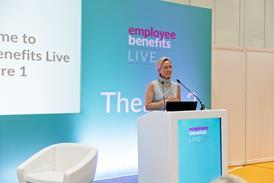
New Africa/Shutterstock
Need to know:
- It is dangerous to make assumptions about the needs of different generations but age can influence areas such as healthcare benefits, pensions and employee expectations of work.
- Offering choice, including through flexible and voluntary benefits schemes, allows employees to tailor their benefits and can make them feel happier and more valued.
- Line managers and employee groups are valuable ways to promote benefits to a multigenerational workforce.
Whether down to desire or necessity, more people are working longer, with the latest Office for National Statistics, published in September 2022, showing that nearly 1.5 million over-65s are employed. Retaining this experience is positive for employers, but designing a reward and benefits strategy that meets the needs of five generations can be a challenge.
This is something that comes through in a research project by Canada Life, Life100+ published in October 2024, which explores the impact of people living for longer. Keily Vanstone, head of marketing, brand and communications at Canada Life, explains: “Employers are recognising they need to keep older people in the workforce for longer, but they also need to attract youngsters. Meeting these different needs and expectations requires a change in approach.”
Generational differences
Having a workforce that could potentially range in age from 16 to 96-plus years means employers need to understand the generational differences that can affect a reward and benefits strategy.
Health is one area where age can make a difference. Beth Husted, associate director, health and benefits at Willis Towers Watson (WTW), says: “Claims and pricing on group risk and healthcare products do increase with age. An employer could also focus its wellbeing strategy on the health issues that the workforce is facing.”
To illustrate this, she cites the example of one organisation that saw its private medical insurance (PMI) spend increase significantly. The increase was driven by one section of the workforce: men over the age of 50. “We worked with [the employer] on a prevention strategy, introducing tools to promote early detection including health screenings and support for NHS cancer campaigns,” she adds.
Financial wellbeing
Employees’ financial priorities may also vary with age. Graduates are likely to be dealing with student debt and beginning to contemplate major financial commitments such as their first home or starting a family. And, while older employees may have a handle on these expenses, they may be juggling their own retirement savings alongside helping their children financially.
These differences will affect the value employees place on certain benefits, says Matthew Gregson, executive director at Howden Employee Benefits. “Older employees tend to appreciate the pension much more than their younger colleagues,” he says. “But age isn’t the only factor that will influence how much value is placed on benefits: the higher the earnings, the more an employee values benefits such as [medical] insurance and pension.”
Employment motivations
The reasons why employees come to work can also vary with age. “The motivations are different,” says Vanstone. ”It’s about much more than the financials.”
While younger employees tend to be more focused on the career build aspects of work, looking for ways to build their skills and climb the ladder, motivators can change when employees reach their 50s. “Many older employees will want work to fulfil a purpose, whether that’s feeling valued or enjoying what they do,” she adds. ”We’re also seeing younger people prioritising their values when looking for work. Employers must understand these different motivators.”
Needing to fulfil these different reasons is leading to a rethink in the benefits offered to employees. As well as offering greater flexibility around work, including different working hours and sabbaticals, there needs to be more emphasis on learning and development programmes, says Vanstone. “It’s about enriching employees’ lives,” she adds. ”Even something as simple as setting up multigenerational teams is seen as motivational by the older generations.”
Benefits for all
The needs and expectations of a multigenerational workforce may vary but it is also important not to make assumptions based purely on age. Dr Suba M, medical director at Aviva, says: “Generational differences are a useful lens to identify that employees may be at different stages in life, but needs and expectations can vary,. An employer’s responsibility is the same to everyone: to make work happy, healthy and meaningful.”
As meeting this responsibility is likely to require a range of different benefits and reward, offering choice is essential. Life insurance is one area in which this is beneficial. “It’s very difficult to determine from the demographics alone whether an employee needs more or less life insurance,” explains Gregson. ”Letting employees flex their cover in line with their circumstances will mean everyone benefits.”
Flexible benefits
Letting employees select their own benefits package has additional advantages. The 2024 Global benefits attitudes survey, published in September 2024 by WTW, found that the more choice employers offered, the more the benefits are appreciated.
For instance, where an employer offers full flexible benefits plus a voluntary scheme, 72% of employees say the package meets their needs, compared to just 34% of employees when no choice is offered. “The more choice an employer offers, the more employees feel happier and valued,” adds Husted. “By picking their benefits, they can get what they need.”
Equitable options
But not every benefit or initiative can be provided through a flex scheme. Where an employer is targeting the needs of certain groups of employees, there can be concerns that the rest of the workforce will feel left out.
The growth of women’s health benefits demonstrates how this fear can lead to pressure on employers, with some introducing men’s health benefits to satisfy everyone. However, this may not be the best approach, says Dr M. “If an employer does something for one group, everyone benefits,” she says. “Helping employees to get a diagnosis for neurodiversity shows that the workplace is inclusive. This is positive for everyone.”
This need for equity rather than equality can also be highlighted in workplace policies. For example, a carers’ leave policy should take the needs of all employees into account, whether they are looking after elderly parents, a new baby or an ill partner. “This makes it easier for line managers,” says Dr M. “They feel empowered and can make the right decision.”
Workforce wishes
Given the broad range of expectations that come with a multigenerational workforce, determining what employees want is key to getting more value from the benefits spend. Asking employees is the only way to really understand what they want, says Charles Cotton, senior reward adviser at the Chartered Institute of Personnel and Development (CIPD). “Surveys, focus groups and employee resource groups are great ways to find out what employees want,” he says. ”Employers should also use data from benefits to see how age influences take-up.”
Employers should also monitor take-up, especially where any changes are made. “If something unexpected is happening, employers should dig deeper by speaking to employees,” Cotton adds. “Having too much choice can be overwhelming and it may require a more targeted communications package to ensure employees know what’s available.”
A multigenerational workforce is also likely to require a different benefits communications strategy. It is important not to assume what different generations will want on the communications front, says Husted. “Everyone will have their own preferences but also consider using line managers and employee groups to promote the benefits that are available and relevant to different groups,” she explains.
While meeting the needs of a multinational workforce may feel like a challenge, focusing on choice and different options rather than age is key to designing a reward and benefits strategy that suits everyone.
















